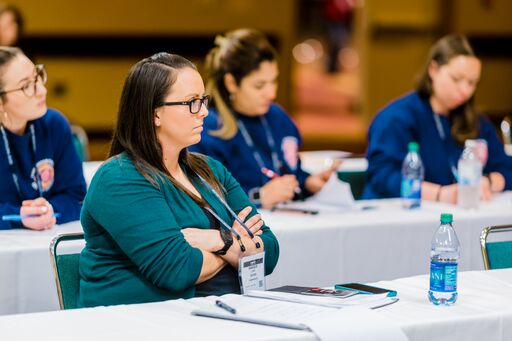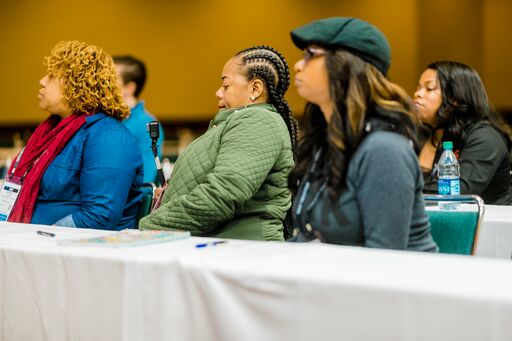“Women in Fire traditionally hosts a one-day leadership conference every other year. In 2017, we partnered with FDIC International to bring the opportunity for both women and men, through every rank of the fire service, to attend the event. Co-locating at the largest fire service conference in the nation has broadened our audience and increased the awareness of the organization. We are grateful to continue in this partnership,” says Amy Hanifan, president, Women in Fire.
Here are just some of the offerings from the one-day “conference within a conference” to be held on Monday, August 2, in Indianapolis. The speakers highlight what they hope to achieve with their classes and why their topics are important.
KEYNOTE: “You Can’t Have It All”
Chief Tricia L. Wolford, Anne Arundel County (MD) Fire Department
“Climbing the fire service ladder is not for the faint of heart. Even remaining proficient and successful in our current rank takes training, education, and a vast amount of personal time. Why do we do it? What is it about the fire and EMS service that drives us to take on more challenges and continue to push ourselves day in and day out? I have come to realize that with this mentality, you can’t have it all. Everything costs something, but what is the price we are willing to pay for success?
“I chose this topic because I discuss my road to achieve five bugles and what that looked like as I continued to grow in the fire service. It is relevant to others in our industry because many are looking to promote. There isn’t just one way to get there. My story is an example of going outside of the usual fire service norms to get to where I felt I was most effective. Leadership, education, training, and networking are the foundations of what helped me rise to the top.”
HARASSMENT PREVENTION TRAINING TOOLS FOR FIRE DEPARTMENTS
Alisa Arnoff, Scalamrino & Arnoff, LLP; and Chief (Ret.) John Rukavina, Director, Public Fire Safety Services
“Our experience with workplace sexual harassment as a fire chief and consultant drove us to the conclusion that the lawsuit-avoidance approach that’s characterized so much of sexual harassment prevention generally—and sexual harassment prevention in the fire service particularly— has pushed us farther from our goal of eliminating firehouse sexual harassment than we were 15 years ago. Ever-increasing social media reports of firehouse sexual harassment make for depressing reading.
“Coinciding with this realization was the emergence of studies over the past several years of how effective sexual harassment prevention training was—and was not—in preventing harassment in the first place.”
Rukavina reviewed those studies, organized his thoughts, and began talking with his peers about what works—and what doesn’t. Arnoff’s day job frequently involves how to effectively train workforces on sexual harassment prevention from a practical perspective.
“We cannot overstate how critical effective sexual harassment prevention training—along with training in prevention of other forms of harassment—is to the fire service. The primary value of every firefighter has to be trust—trust in the belief that, in one of the most dangerous of occupations, we each have the others’ backs, and they have ours. It’s not always easy to convincingly explain why workplace sexual harassment must be prevented from a sociological point of view, but we’ve found it to be a lot easier to emphasize the importance of sexual harassment prevention by explaining how quickly and extensively it corrodes that fundamental value of trust—that we’re there for each other.”
Rukavina is a former fire chief and a consultant/attorney; Arnoff is an employment law attorney who has a niche in the fire service. They have tag-teamed as instructors for awhile now and are dedicated to sexual harassment prevention.
“We can communicate as lawyers but, more importantly, we understand how sexual harassment plays out in the real world of the firehouse and fireground.”
PREPARING FOR A SUCCESSFUL ASSESSMENT CENTER
Battalion Chief Lisa Baker, Oakland (CA) Fire Department; and Latosha Clemons, Boynton Beach (FL) Fire Department
“Company officers will learn what an assessment center is, what they can expect to see in an assessment center (typical exercises), and the scoring procedures. Many fire service members are required to take and to be successful in an assessment center to be promoted. Yet, if you are unaware of what exactly an assessment center is, you cannot be successful. Having the knowledge of what to expect in an assessment center is the start to being successful. If you have prepared for your assessment center and know what to expect, it can be the difference between receiving that promotion, just barely making the promotional list, or not making the list at all and having to prepare all over again in the coming years.
“We all want competent, well-prepared members in leadership roles, and preparing for that promotion will help the best candidates rise to the top of the promotional list and be successful. History has shown that an assessment center is an excellent indicator of who will be successful in the position that they are testing for. So, ensuring that these members understand the process will help to ensure that the most qualified are being promoted.”
The instructors teach the class from the perspective of the assessor (the person scoring). Both instructors have sat on numerous assessment centers throughout the United States from the rank of firefighter to battalion chief. They share their knowledge of how to be successful by explaining what excellent answers are as opposed to good answers for various scenarios.
NUTRITION 101
Lieutenant Kevin George, Baltimore County (MD) Fire Department
“I began my career with the fire service as a paramedic/firefighter. The intermittent sleep schedule, poor meals, and stress compounded over time. Like many others, I became overweight and mentally fatigued and believed this was a side effect of the lifestyle I had chosen when I took my oath to serve. It is tough to find firefighters talking about their ability to battle the rapid metabolic diseases in the fire service, such as cancer, heart disease, obesity, diabetes, and even mental health difficulties. These being our most prevalent killers, there had to be some modifiable component.
“I found nutrition to be the key. Through learning and implementation of quality nutrition in my life, I saw a dramatic change. I feel implored now to share my knowledge with fellow firefighters who can make a change in their health.
“Currently, I am a certified peer fitness trainer for the Baltimore County Fire Department. A large portion of my knowledge comes from having my own nutritionist for a period of time, research, and self-experimentation using proper nutrition and exercise in my life. Following a well-rounded approach to nutrition has enabled me to complete many endurance events including but not limited to multiple marathons and triathlons at the Ironman distance.”
SWEATING THE SMALL STUFF: KEEPING YOUR PEOPLE SAFE AND ALIVE
Chief (Ret.) Rick Lasky, Lewisville (TX) Fire Department
“When doing your research regarding line-of-duty deaths (LODDs) and injuries to firefighters, you can’t help but notice after a while that the big things, those larger incidents involving injured firefighters or, worse yet, killed, are few and far between. Thank goodness! As tragic as those are, what grabs your attention are all the little things that contribute to firefighters being injured and killed.
“After studying the reports for more than 30 years, I began to notice that there is almost always a string of little things, ‘the small stuff,’ that line up and lead to someone getting hurt–whether that’s making a poor choice as to when to enter a burning building, improper search and rescue techniques, not wearing a seat belt, not setting up properly at a motor vehicle accident, and a very long list of other small things that add up to something bad happening. This program walks you through all the little things that lead us down that dark and dangerous path. Not sweating the small stuff might be acceptable in the corporate world, but we in the fire service know that it can be the difference as to whether we go home or not.”
LESSONS LEARNED AND EMERGING TOPICS
Chief John Alston, New Haven (CT) Fire Department; Assistant Deputy Chief Paramedic Deborah Sommer, Chicago (IL) Fire Department; and Chief Trisha Wolford, Anne Arundel County (MD) Fire Department
Sommer says: “I am honored to share the stage with such a revered group of fire and emergency services chief officers. Collectively, we have more than 75 years of experience; there is representation from some of the largest fire-based EMS departments discussing current issues.”
The panel and audience will have a very active question and answer session, and there will be something for everyone as they share the diverse experiences during their careers in fire and emergency medical services.
Women in Fire is an inclusive, nonprofit organization that provides education, support, and advocacy for fire service women. Highlights of the organization include training sessions, conferences, a mentoring program, best practice education, and so much more. Each region of the United States has a trustee that members can reach out to, and the organization has recently added multiple state representatives to bring the support more locally. In addition, the international trustee works closely with other worldwide organizations representing women in the fire service. Membership options and resources can be found at www.womeninfire.org.





